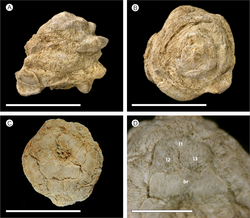Biology:Pararaucaria
| Pararaucaria | |
|---|---|

| |
| Fossil of Pararaucaria collinsonae | |
| Scientific classification | |
| Kingdom: | Plantae |
| Clade: | Tracheophytes |
| Clade: | Gymnospermae |
| Division: | Pinophyta |
| Class: | Pinopsida |
| Order: | Pinales |
| Family: | †Cheirolepidiaceae |
| Genus: | †Pararaucaria Wieland emend. Escapa, Rothwell, Stockey et Cuneo, 2012 |
| Species | |
|
See text | |
Pararaucaria is a genus of conifer cone belonging to the extinct family Cheirolepidiaceae. Fossils are known from the Lower Jurassic to Early Cretaceous of North America, Europe, South America and Asia. It is associated with Brachyphyllum-type foliage.
Description
The form of the cone varies from cylindrical to spherical, reaching up to 80 millimetres (3.1 in) in length in the largest species. The bract-scale complexes are helically arranged around the core. There is one central undivided and two lateral ovuliferous scale lobes, with each ovuliferous scale bearing one or two seeds, which are up to 11 by 5 millimetres (0.43 in × 0.20 in) in dimension. The seeds are enclosed within pocket forming tissue.[1]
Taxonomy
The genus was originally described by Wieland in 1929 and 1935 for the species Pararaucaria patagonica.[2][3] The affinity of the genus was originally uncertain, but was confidently referred to the Cheirolepidiaceae by a study conducted in 2012, which emended the diagnosis of the genus.[4]
Species
- Pararaucaria laiyangensis Jin et al. 2023[1] Laiyang Formation, Shangdong, China, Early Cretaceous (Hauterivian–Barremian)
- Pararaucaria patagonica Wieland emend. Escapa, Rothwell, Stockey et Cuneo, 2012 [4](type) La Matilde Formation, Argentina, Middle Jurassic
- Pararaucaria delfueyoi Escapa et al. 2012[5] Cañadón Calcáreo Formation, Argentina, Late Jurassic
- Pararaucaria carrii Stockey and Rothwell, 2014[6] Trowbridge Formation, Oregon, United States, Middle Jurassic (Callovian)
- Pararaucaria collinsonae Steart et al., 2014[7] Purbeck Group, England, Late Jurassic (Tithonian)
- Pararaucaria taquetrensis Escapa et Leslie, 2017[8] Lonco Trapial Group, Argentina, Early Jurassic
An indeterminate species is also known from the Late Jurassic Morrison Formation, of Utah, USA.[9]
Associations
Pararaucaria is associated with foliage of Brachyphyllum type,[1][8][10]
References
- ↑ 1.0 1.1 1.2 Jin, Peihong; Zhang, Mingzhen; Du, Baoxia; Li, Aijing; Sun, Bainian (February 2023). "A new species of Pararaucaria from the Lower Cretaceous of Shandong province (Eastern China): Insights into the Evolution of the Cheirolepidiaceae cone" (in en). Cretaceous Research 146: 105475. doi:10.1016/j.cretres.2023.105475. https://linkinghub.elsevier.com/retrieve/pii/S0195667123000034.
- ↑ Wieland, G. R. 1929. The world's two greatest petrified forests. Science 69:60-63
- ↑ Wieland G. R. 1935. The Cerro Cuadrado petrified forest. Carnegie Institution of Washington, Washington, D.C. , USA.
- ↑ 4.0 4.1 Escapa, Ignacio H.; Rothwell, Gar W.; Stockey, Ruth A.; Cúneo, N. Rubén (June 2012). "Seed cone anatomy of Cheirolepidiaceae (Coniferales): Reinterpreting Pararaucaria patagonica Wieland" (in en). American Journal of Botany 99 (6): 1058–1068. doi:10.3732/ajb.1100544. ISSN 0002-9122. https://onlinelibrary.wiley.com/doi/10.3732/ajb.1100544.
- ↑ Escapa, Ignacio H.; Cúneo, Néstor R.; Rothwell, Gar; Stockey, Ruth A. (March 2013). "Pararaucaria delfueyoi sp. nov. from the Late Jurassic Cañadón Calcáreo Formation, Chubut, Argentina: Insights into the Evolution of the Cheirolepidiaceae". International Journal of Plant Sciences 174 (3): 458–470. doi:10.1086/668612. ISSN 1058-5893. http://dx.doi.org/10.1086/668612.
- ↑ Stockey, Ruth A.; Rothwell, Gar W. (March 2013). "Pararaucaria carrii sp. nov., Anatomically Preserved Evidence for the Conifer Family Cheirolepidiaceae in the Northern Hemisphere" (in en). International Journal of Plant Sciences 174 (3): 445–457. doi:10.1086/668614. ISSN 1058-5893. https://www.journals.uchicago.edu/doi/10.1086/668614.
- ↑ Steart, David C.; Spencer, Alan R. T.; Garwood, Russell J.; Hilton, Jason; Munt, Martin C.; Needham, John; Kenrick, Paul (2014-10-23). "X-ray Synchrotron Microtomography of a silicified Jurassic Cheirolepidiaceae (Conifer) cone: histology and morphology of Pararaucaria collinsonae sp. nov." (in en). PeerJ 2: e624. doi:10.7717/peerj.624. ISSN 2167-8359. PMID 25374776.
- ↑ 8.0 8.1 Escapa, Ignacio; Leslie, Andrew (February 2017). "A new Cheirolepidiaceae (Coniferales) from the Early Jurassic of Patagonia (Argentina): Reconciling the records of impression and permineralized fossils" (in en). American Journal of Botany 104 (2): 322–334. doi:10.3732/ajb.1600321. ISSN 0002-9122.
- ↑ Gee, Carole T.; Dayvault, Richard D.; Stockey, Ruth A.; Tidwell, William D. (June 2014). "Greater palaeobiodiversity in conifer seed cones in the Upper Jurassic Morrison Formation of Utah, USA" (in en). Palaeobiodiversity and Palaeoenvironments 94 (2): 363–375. doi:10.1007/s12549-014-0160-1. ISSN 1867-1594. http://link.springer.com/10.1007/s12549-014-0160-1.
- ↑ Thevenard, Frédéric; Chernomorets, Oleksandra; Moreau, Jean-David; Neraudeau, Didier; Philippe, Marc (2022-08-30). "A review of the Hirmeriellaceae (Cheirolepidiaceae) wood". IAWA Journal 43 (4): 428–447. doi:10.1163/22941932-bja10099. ISSN 0928-1541. https://brill.com/view/journals/iawa/43/4/article-p428_5.xml.
Wikidata ☰ Q116819342 entry
 |

